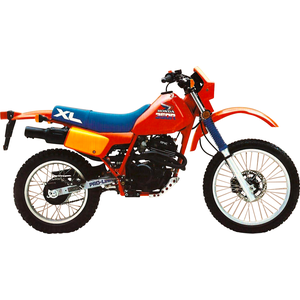Honda XL 350 R (1984–1988) Review: A Timeless Dual-Sport Legend
Introduction
The Honda XL 350 R stands as a defining machine in the evolution of dual-sport motorcycles. Produced from 1984 to 1988, this air-cooled thumper carved its reputation as a rugged, no-nonsense companion for riders seeking adventure on and off the asphalt. While modern dual-sports have embraced liquid cooling and electronic aids, the XL 350 R remains a benchmark for simplicity and mechanical honesty. After spending time with a well-preserved example, it’s clear why this bike still commands respect among vintage off-road enthusiasts and practical commuters alike.
Design & Ergonomics: Function Over Flair
The XL 350 R’s design is quintessential 1980s Honda: utilitarian, clean-lined, and built to endure. Its high-mounted fenders, slim steel fuel tank (11.5L capacity), and upright riding position prioritize practicality. The 39mm telescopic forks (410ml SAE 7.5W oil) and twin shock rear suspension offer a plush 200mm of travel—ample for moderate trails, though hardcore enduro riders might crave more damping control.
The seat height of 860mm (33.8 inches) accommodates taller riders comfortably, but shorter pilots may find it intimidating at stops. Controls are straightforward, with a cable-operated clutch and drum brakes (a front disc arrived later in the generation). The analog instrumentation is minimal—just a speedometer and warning lights—keeping weight down to 123kg (271 lbs), a featherweight by today’s standards.
Performance: Modest Power, Maximum Versatility
Engine Character
At its heart lies a 339cc single-cylinder, air-cooled engine producing 27 PS (20 kW) at 7,500 RPM. While these numbers seem modest compared to modern 350cc machines, the XL’s power delivery is linear and tractable. Throttle response is immediate, thanks to its 14/38 sprocket combo and well-tuned Keihin carburetor (air screw preset at 1.5 turns out). The engine thrives between 3,000–6,000 RPM, offering enough grunt to climb hills or merge onto highways, though sustained speeds above 100 km/h (62 mph) feel strained.
Vibration is ever-present—a hallmark of big singles—but never intrusive below 80 km/h (50 mph). The exhaust note is muted and polite, perfect for stealthy trail rides or urban commuting.
On-Road Manners
On pavement, the XL 350 R feels surprisingly nimble. The 102-link chain drive and 18-inch rear wheel (2.3 bar/33 psi tire pressure) provide stable cornering, while the 21-inch front wheel (1.8 bar/26 psi) soaks up bumps. Drum brakes require deliberate lever pressure, but the lightweight chassis makes slowing down predictable.
Off-Road Prowess
This is where the XL truly shines. The torquey low-end power (18 PS/13 kW at 5,500 RPM) lets you chug up rocky inclines without stalling. Ground clearance of 270mm (10.6 inches) avoids most trail debris, and the narrow profile allows easy leg-dabbing in technical sections. The suspension, while soft, absorbs small to medium impacts gracefully—just avoid aggressive jumps unless you’ve upgraded the shocks.
Competition: How It Stacks Up
The 1980s dual-sport market was fiercely competitive. Here’s how the XL 350 R fared against rivals:
- Yamaha XT350 (1985–2000): The XT’s 349cc twin-valve engine made slightly more power (23 kW), but its heavier frame (136kg/300 lbs) dulled off-road agility. Honda’s simpler SOHC design proved more reliable long-term.
- Suzuki DR350S (1990–1999): A later contender, the DR350 offered a 6-speed gearbox and better suspension. However, early models had carburetion issues, and the XL’s air cooling required less maintenance.
- Kawasaki KLR250 (1985–2005): The KLR’s liquid-cooled engine was smoother at high RPMs but added complexity. The XL’s torquier engine and lower seat height made it more accessible for beginners.
The XL 350 R’s edge lies in its balance of durability and simplicity. While not the most powerful or refined, it’s a bike that forgives neglect and rewards mechanical sympathy—a true “ride anywhere, fix anywhere” machine.
Maintenance: Keeping the Legend Alive
Key Service Points
- Valve Adjustments:
- Intake: 0.05mm (0.002 in) cold
-
Exhaust: 0.08mm (0.003 in) cold
Check every 3,000 km (1,864 miles). Use a feeler gauge and keep the cam chain tensioner updated. -
Oil Changes:
- 1.6L (1.7 quarts) of SAE 10W-40 (API SE) without filter replacement
-
1.7L (1.8 quarts) with filter
Change every 2,000 km (1,242 miles) for off-road-heavy use. -
Carburetor Care:
The stock Keihin carb is reliable but sensitive to ethanol-blended fuels. Clean the pilot jet annually and consider a stainless steel rebuild kit from MOTOPARTS.store. -
Chain & Sprockets:
The 14/38 tooth setup wears quickly under load. Inspect every 500 km (311 miles) and lubricate with a high-pressure chain grease. Upgrade to an O-ring chain for longer life. -
Brake System:
Flush DOT 4 fluid yearly. Drum brake shoes last ~10,000 km (6,214 miles) with moderate use.
Recommended Upgrades
- NGK Iridium Spark Plug (DPR8EIX-9): Improves cold starts and fuel efficiency.
- Aftermarket Air Filter: Enhances airflow for off-road riding.
- Progressive Rate Suspension Springs: Reduces bottoming on heavy landings.
Conclusion: A Bike That Outlives Trends
The Honda XL 350 R isn’t about cutting-edge specs or blistering speed—it’s about freedom. Freedom to explore backroads without worrying about fuel injection errors, freedom to wrench in your garage with basic tools, and freedom to ride without pretense. Decades after its debut, it remains a masterclass in purposeful design. Whether you’re restoring a barn find or building a retro trail weapon, MOTOPARTS.store has the OEM and upgraded components to keep your XL 350 R running for another 40 years.



















